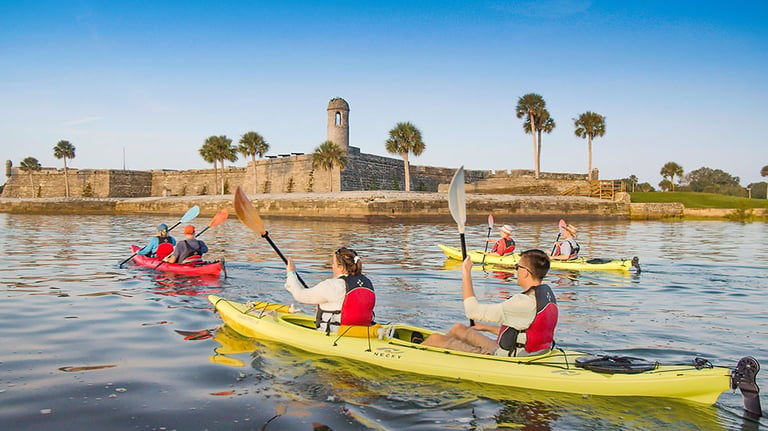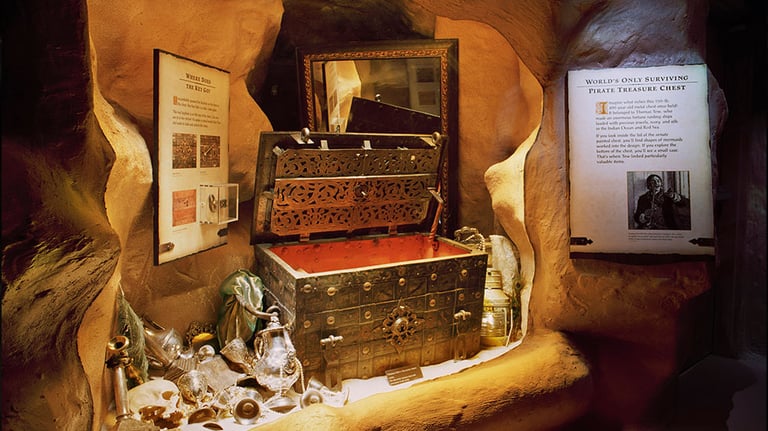

“Next stop is ‘The Fountain of Youth,’” announces my trolley driver as we begin rolling along the winding road in the heart of St. Augustine. “Get off here if you want to test its salubrious qualities.”
I followed his directive, eager to visit the legendary Fountain of Youth, with its miraculous healing powers a staple of St. Augustine’s lore. Travelers have long flocked to this oceanfront town 40 miles south of Jacksonville, drawn by its promises of rejuvenation and intriguing stories. While many Florida towns boast gorgeous beaches and azure waters, St. Augustine stands apart with more than four centuries of rich history—dating back to the time when Spanish explorer Juan Ponce de León first anchored off Florida’s shores, claiming lands in the New World for Spain and seeking its fabled “salubrious” waters.
Founded in 1565, St. Augustine is the nation’s oldest continuously occupied European-settled city—that’s 55 years before the Pilgrims landed at Plymouth Rock. It’s withstood numerous battles and sieges, changing hands between Spanish, British and American rule.
Drawing from my own exploration of St. Augustine, here’s how to experience America’s oldest city in 48 hours.

Day 1
Start your St. Augustine visit with a hop-on-hop-off trolly tour that will take you through all the city’s top attractions. Consider hopping off to spend time at the Fountain of Youth Archaeological Park, a 15-acre waterfront historical attraction. Among other things, it’s here where you can sample water from the legendary spring and see if you’ll enjoy eternal youth. (Spoiler alert: Not everyone loves the taste.)
Also visit the Castillo de San Marcos National Monument, a famous fort that was never taken by force, thanks to its unique walls. Made from coquina—a sedimentary rock composed of crushed marine shells—the walls didn’t crack when hit by cannon balls. Instead, the cannon balls would lodge in the stone. This remarkable quality allowed the Castillo to withstand months-long bombardments during multiple sieges.

Walk to the St. Augustine Pirate & Treasure Museum for a swashbuckling adventure of myths and truths about the scariest buccaneers that sailed the seas of the New World. Marvel at the fascinating tales of William Kidd, whose treasure chest was never found, and Thomas Tew, whose treasure chest is on display—as well as the fierce female pirates Mary Read and Anne Bonny.
If you have energy to paddle, enjoy a salt marsh kayak tour with St. Augustine Eco Tours to admire the Castillo de San Marcos fort from the water and spot seabirds and dolphins along the way.
Finish your day with either a fine-dining experience at La Nouvelle—the city’s first French Nouveau cuisine restaurant that tastes and feels like Paris—or kayak on Guana Lake, where you can experience bioluminescence thanks to comb jellies and dinoflagellates that create the mesmerizing light show.

Day 2
Travel back in time at The Oldest Store Museum, which re-creates the original St. Augustine general store from 1908 that sold the latest gadgets, as well as tonics and elixirs from the period. Costumed historical guides, dressed as store clerks, may try to sell you some early 20th-century favorites such as a goat-powered washing machine, corn-shellers, corsets, and tonics.
Continue your yesteryear sightseeing of St. Augustine by touring nearby Villa Zorayda Museum, a Gilded Age mansion built in 1883 by eccentric Boston millionaire Franklin W. Smith as his winter home. Inspired by the Alhambra Palace in Spain, the Villa is an architectural marvel in the Moorish Revival style, maintained by the same family for more than 110 years. Self-guided audio tours take you through its many rooms, telling the fascinating stories of its carefully preserved artifacts, including the Sacred Cat Rug—an Egyptian rug woven entirely from real cat hair and believed to be more than 2,400 years old, making it arguably the oldest rug in the world.

Carve time in your itinerary to discover the remarkable African history of St. Augustine. Visit Fort Mose Historic State Park, the first legally sanctioned free African settlement in what would become the United States. It became a sanctuary for enslaved people escaping plantations in Georgia and South Carolina. Walk the fort’s Flight to Freedom Trail to learn how men, women, and children risked their lives in pursuit of freedom. Next, visit the Lincolnville Museum and Cultural Center, which brings to life 450 years of the African American history through arts, programs, exhibits, and more. This includes the story of how Martin Luther King’s protests in St. Augustine contributed to the passing of the Civil Rights Act in 1964.
Cap off a busy day with dinner at The Floridian, offering a modern twist on southern comfort foods with a focus on fresh, locally sourced ingredients. Your dining experience is sure to leave you feeling both pleasantly full and completely captivated by the charm of America’s oldest city—salubrious qualities and all.
